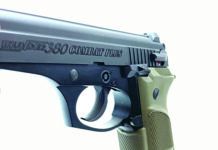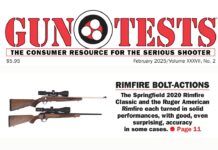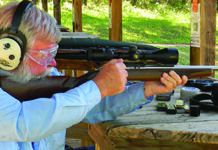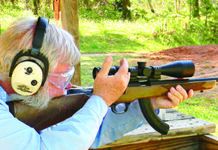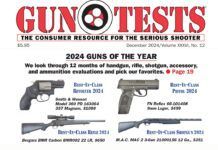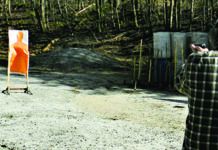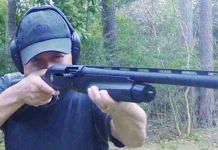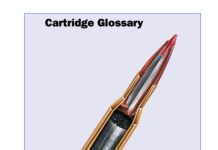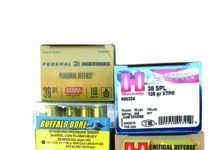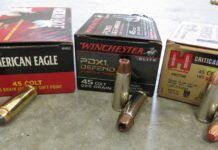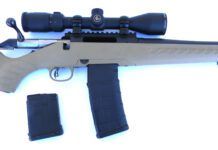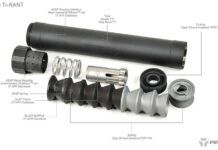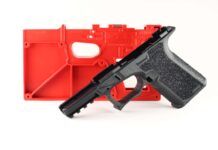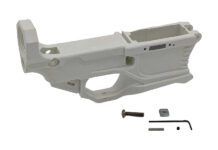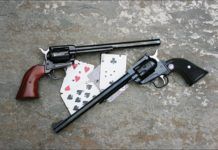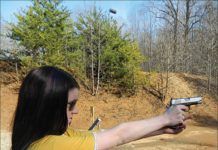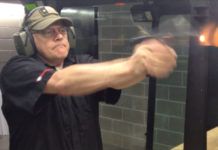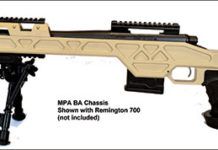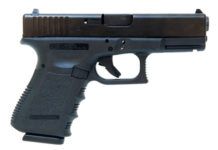22 Buntlines: Heritage Rough Rider and Ruger NM Single-Six
A Buntline is commonly known as a Single Action Army (SAA) revolver with a barrel of 12 inches or more. They are mostly associated with Wyatt Earp of the gunfight at O.K. Corral fame and Ned Buntline, where the revolver gets its name. Buntline was a dime novelist who penned Western sagas about cowboys, outlaws, and other gunfighters. It is agreed that much of Buntlines writing was more fiction than fact, so if Ned could take some poetic license, so did we calling these long-barrel rimfires Buntlines. The Heritage Manufacturing Rough Rider and Ruger New Model Single-Six Convertible are scaled down Buntlines with 9-inch barrels - the Ruger actually has a 9.5-inch barrel. After the team stopped yukking it up about the odd-looking long-barreled revolvers and saying things like: You need to tie a red warning flag to the end of the barrel or You need to move the target out a few more yards, the muzzle keeps hitting it or Were going to need a longer range rod, we all got back to our senses and found a lot to like in these long-barreled rimfires.
Both revolvers are blued, single action and came with two cylinders, one for 22 LR and one for 22 WMR. One thing to be aware of with a 22 rimfire convertible revolver is that the bore diameter for a 22 LR and a 22 WMR are different. Nominal dimensions are .220 for the 22 WMR, and .217 for 22 LR. Generally speaking, the 22 LR is more accurate than the 22 WMR, and there tends to be more consistent velocity and pressure on the LR rounds.
Snubnose Revolvers from S&W And Ruger: Which One To Carry?
The 357 Magnum is an excellent defensive cartridge. Pair it with a lightweight, compact revolver, and that is what we would call an excellent choice as a conceal-carry handgun. Our team has tested variants of the Ruger SP101 and S&W Model 60, but the S&W Model 60 Pro Series in 357 Magnum is a variant we have wanted to get our hands on for a while. We also wanted to see if the caliber choice would sway our recommendation on the established Ruger SP101 model.
The second Ruger SP101 we tested was chambered in 327 Federal Magnum, which was cataloged by Ruger from 2007 to 2011. As we noted in our first look at the gun in the April 2008 issue, Ruger and Federal teamed up to produce a cartridge/handgun combination that provided the power of the 357 Magnum but with less recoil and in a compact revolver that holds six shots rather than five shots. As a bonus, the 327 Fed Mag-chambered Ruger also accepts 32 H&R Mag, 32 S&W, and 32 S&W Long ammo. The footprint of the Ruger SP101 in 327 Fed Mag is basically same as the Ruger SP101 in 357 Mag, with a few exceptions.
All three double-action revolvers are built from stainless steel with similar barrel lengths, give or take three-quarters of an inch. All had exposed hammers, so single-action firing is possible. A transfer bar was built into the revolvers for safety. All three were built to last, even under a steady diet of hot loads. The lock up was tight on all three, and the chambers were all aligned with the bore, which we assumed but also verified. Fit and finish was very good on all three revolvers and that was exactly what we expected. The workmanship in these guns make them worth the cost.
Light-Recoil 45 ACP Loads: Three Comfortable A Choices
The road in life isnt always straight and narrow. It can be winding and even out of control. Some changes are unwelcome, even fearful. Among the significant changes as we age is a loss of muscle mass. Shooters who once handled hard-kicking handguns now find them ever more difficult to handle. Arthritis and a culmination of old injuries make firing the big-bore pistol difficult. These individuals, along with young shooters who have adopted a lightweight pistol such as a Colt Commander, and slightly-built female shooters interested in a low-recoil load, are faced with difficult decisions. Once the decision is made to take advantage of the big-bore 45 ACP handgun, shooters are seldom willing to back down to the 9mm.
A knowledgeable reader asked for help in choosing a good factory load for his Commander 45 ACP, and this report is an answer. He had solved the problem of practice loads well. It isnt difficult to find a good lead-bullet load for practice. The Oregon Trail 200-grain semiwadcutter bullet and a modest charge of WW 231 powder will break 800 fps and function in most 1911s. But for personal-defense handguns, expansion is desirable, so that calls for a jacketed hollowpoint bullet to prevent over penetration and ricochet.
In our Gun Tests ammunition evaluations, we have stressed that when the power factor of a load reaches 200, then the handgun becomes more difficult to use effectively in personal defense. As an example, the standard 230-grain 45 ACP hardball load at 850 fps breaks 195 in power factor. The 185-grain JHP at 1000 fps hits 185. Few hardball loads actually clock 850 fps, but most of the 230-grain JHP loads do.
Are there load choices that will diminish the recoil of full-strength 45 ACPs and still produce acceptable performance - not exactly -P loads, but ones that are easier to handle than most and give a shooter with tired muscles a fighting chance at handling a big-bore handgun with accuracy and speed?
We went looking for some loads that produce reasonable recoil coupled with good downrange ballistic effect while functioning with standard recoil springs. Our test guns were a 4-inch-barrel Kimber CDP, the personal-defense pistol of one of our raters and a SIG Sauer P250 45-caliber compact. For comparing the recoil of +P loads to our controlled-recoil samples, larger pistols, including the FNH 45, were used. Here are our recommendations.
Two 1911s Under the Radar: Ithaca Versus Roberts Defense
If you have between $1500 and $2000 to put into a good 45 auto, which one will you get? There are many candidates, and choosing between them is often more a test of which brand name sounds the best — Wilson, Baer, Nighthawk, Guncrafter to name just a few — rather than which gun is the best for an individual shooter. Frankly, guns in this price range are very hard to separate because they're all pretty darned good.
For this test, we looked at two names that aren't top of mind, even though one of them has a historical provenance that is hard to match. The test guns were full-size 1911s in 45 ACP, one being the Ithaca Gun Co. M1911-N #1911-C45G10 45 ACP, $1799. Between 1942 and 1945, Ithaca Gun Company made 382,000 of the 45-caliber Model 1911-A1 pistols for the military, and according to company documents, Ithaca received a "certificate of appreciation" from the federal government for improving a manufacturing procedure for the triggers. The original Ithaca Gun Company was located in Ithaca, New York, and was probably best known for its M37 shotgun. When Ithaca restarted several years ago in Upper Sandusky, Ohio, new management invested in CNC machining to make its older guns cost-competitive with more modern designs. Those techniques were also applied to a very modern pistol product pitched as a semi-custom 1911 for carry or duty use. The Ithaca comes in a hard plastic case with foam inserts and a 1-year limited warranty.
Our second pistol was a Roberts Defense Super Grade Pro 45 ACP, $1549, made by the firm in Oshkosh, Wisconsin. Unlike Ithaca, which makes just two full-size pistol variants, Roberts makes six pistols in the Super Grade line alone (all $1549), including our full-size two-tone test gun, a full-size stainless model, two 4.25-inch barrel Custom models, and two of the firm's Carry models with 3.5-inch barrels. The company's Operator lineup includes four pistols (all $1649) and the Recon line has three versions (all $1499). Roberts Defense was founded in 2011, and the company says each firearm is hand-built using 100% American-made components. Each firearm comes in a tactical soft case with an accompanying gun lock. Impressively, Roberts Defense offers a lifetime transferable warranty.
Rob Unger, president of Roberts Defense said, "All of our parts are hand-fitted with the utmost attention to detail. We purposely build a limited amount of firearms to fit and function flawlessly, while never compromising, and making our high-quality product available at a reasonable price."
We shot the guns for accuracy and function, and evaluated them for more than a year in self-defense training and general use. These were both outstanding pistols, yet we found some anomalies that might help you pick and choose.
Metro Arms American Classic Compact Commander Now Available in the U.S.
August 2014 Issue Remington R51 9mm Pistol Range Results & Ammunition Sources
CMMG Adds 5.56mm Caliber to New AR Pistol Line-Up
Davidson’s Rolls Purple Neos Handgun
Bama Gets Remington Plants
Glock G19 9mm
We can remember when the Glock pistols were shipped in a kind of Tupperware box. The model lineup was short, but one of the first variations in size was the Model 19. Today, Glock pistols arrive in handsome and distinctively styled hard-side cases. There are as many as six different models chambered for 9mm, including the G18 and G18C select-fire machine pistols. Glocks www.teamglock.com website boasts of the G19, The compact version of the G17, this is the preferred pistol of NYPDs 40,000 officers and the standard weapon of the United Nations Security personnel. Designed and built in Austria, but assembled and tested at the Glock facility about 25 miles from Atlanta, specifications of the G19 list more easily in metric. For example, the 102mm barrel was 4.02 inches long. Height was an even 5.0 inches, but width is listed as 1.18 inches, and the G19 measures 6.85 inches, or 174mm long. The frame included an accessory rail along the dust cover, but the tip of the gun was noticeably tapered, so the rail was integrated without adding bulk. The frame was constructed of polymer.
The appeal of the G19, in our view, was its simplicity and the directness in which the design takes on the smaller chores that make up the operation and maintenance of a handgun. Takedown begins with removing the magazine and clearing the chamber. If the trigger is cocked, it must be pulled to release tension. The slide was retracted about one-quarter inch. There was an audible click and a sense of disengagement. Two sliding levers located on each side of the frame just above the trigger were pulled downward. We then released the slide against the tension of the recoil spring and continued moving it forward off the frame. Actually, we found the slide was eager to leave the frame, so we had to be careful to catch it. One aspect of the Glock that is unique and somewhat fascinating is reassembly. You just slide the top end on to the frame and it clicks into place.
Lubrication as recommended by the owners manual was sparse. Surfaces such as the outside of the barrel, barrel hood, and inside the top of the slide were to be lubricated by passing over them with an oiled patch of cloth. The slide rails themselves required only a single drop of oil spread over each slide rail cut. Weve heard of people oiling the firing pin channel, but this is expressly prohibited on page 38 of the multilingual manual. Only one component of the action assembly is to be oiled. That was the point at which the rearward end of the trigger bar touches the connector at the right rear corner of the frame. We should note that Glock pistols are commonly referred to as being striker fired. Indeed, both our Ruger and Springfield Armory pistols use this terminology in their owners manuals. But the parts list inside the Glock manual lists a firing pin, and we could find no reference in the manual or on the manufacturers website to a striker.
Holding the Glock 19 in your strong hand immediately makes you aware of a rakish angle to the grip and the sense of palm swell jutting into your hand. From here the pad of the index finger compresses the firing pin safety located on the face of the trigger. The square profile of the slide was topped with a rear sight blade that was tapered on each side, bringing the eye to the rear notch that was surrounded by a bold white U shaped outline. The front sight shows a single white dot.
The trigger was simple and repeatable, with a consistent 5.5 pounds of resistance for each shot. In our action test we concentrated on moving the trigger quickly and evenly. But it was at the bench where we utilized a slow, controlled press. It is in this mode that any grit or creep will come to light, but we found no such imperfection.
Our best accuracy was achieved when firing the Remington UMC 115-grain JHP rounds and the Federal American Eagle 124-grain FMJ ammunition. Each round produced an Average Group Radius (AGR) between 0.75 inches and 0.79 inches. The Black Hills 115-grain FMJ rounds were not far behind with an AGR of 0.85 inches. The remanufactured Black Hills 124-grain rounds were not as accurate but still more than acceptable at 1.27 inches. We think the most important conclusion we could draw from this data is that the Glock 19 was versatile and did not necessarily favor one weight bullet over another.
In our action tests, our first run lasted 2.09 seconds. The fastest of our ten runs clocked 1.84 seconds, and the first six consecutive runs printed shots perfectly inside the lower and upper A-zones. We ended with four shots outside the lower A-zone and two shots outside the upper A-zone. Average elapsed time was 1.99 seconds. We found that the quality of our follow up shots was closely linked to how smoothly we let the trigger reset. In terms of speed, almost anyone can move his trigger finger faster than he can pick up the sights. We probably would have been able to shoot faster and more accurately if the G19 was fit with higher definition sights. But may we suggest that taller sights would probably be less impact resistant and more prone to dragging out of a holster. When we talk about scoring zones, were referring to a theoretical game. In harsh reality, every one of our hits were effectively placed to provide a stopping blow.
Our Team Said: We think the G19, with its trim, fast handling, may be the most versatile Glock of all. The 19 dared us to shoot faster, but adding higher-visibility sights would be the ticket to better accuracy at speed. In this matchup, where each gun is worth buying, wed pick the Glock first if ease of maintenance is high on your list of wants.
To read about more top-rated 9mm handguns, purchase "The A Team: Concealable 9mm Handguns & Gear" from Gun Tests.





